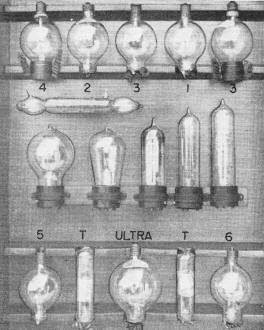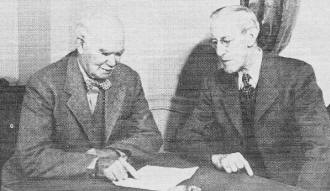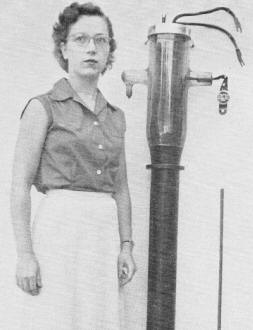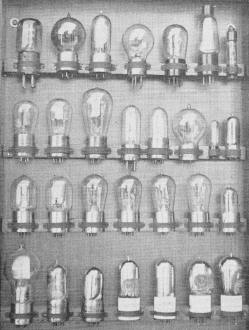The Electron Tube |
||
Here in this 1954 issue of Radio & Television News magazine is one man's (Commander Paul G. Watson, USNR (ret.) collection of early vacuum tubes and a bit about them. It reaches back to Dr. Lee de Forest's farther than even earliest Audion tubes - including the "UltraAudion" - to include the flame-based detector and amplifiers he worked on. For a very thorough history of de Forest's work from the vantage point of both the good Dr. and those who worked with him, including a story by William Howard McCandless (the man who's glass blowing business built the various tubes for de Forest), check out the January 1947 issue of Radio-Craft magazine. It celebrated the 40th anniversary of the de Forest Audio tube. I wonder where this collection of tubes is today. Many priceless collections of technical history artifacts end up being mistakenly or ignorantly disposed of. The Electron Tube
When one considers the present scope of the electronics industry as a whole, its gigantic proportions and its ramifications ranging from an "electronic brain" to door openers, surgical instruments and communications, the question of how this great industry grew and whence it came are bound to come up. Who invented the electronic tube, and how was it discovered? Fig. 1 - Some original de Forest tubes. No.1 is from 1907; No. 2 is of 1909 vintage; Nos. 3 and 4 appeared a little later than No.2; Nos. 5 and 6 are 1910 models; while the "Ultraaudion" dates from 1913-14. The middle row of tubes are special transmitting tubes, referred to in text, made in 1915 in conjunction with Lt. Comdr. S. C. Hooper, USN. The "T" tubes (bottom row) are from 1915. Tubes identified by Dr. de Forest. The author has, over a period of years, collected together such of the old tubes as could be obtained; from this collection he selected representative tubes typical of the development of tubes as they were available and has mounted them in exhibition cases. Pictures of this collection are shown herewith, since they illustrate the beginning of the electronic tube industry. It all began with Dr. Lee de Forest and his "Audion," as his three-element vacuum tube was called, in the year 1905. About a year ago Dr. de Forest very kindly identified and dated for the writer, all of his tubes which are in this collection. Experiments in Chicago in 1901 to 1903 had given Dr. de Forest an idea that incandescent gas had some value as a means of rectifying received radio signals to make them audible. In his laboratory on Thames St. in New York in the fall of 1903, Dr. de Forest put two platinum electrodes in a Bunsen burner flame and, with a battery and headphones connected to an antenna, succeeded in hearing radio signals from ships in the harbor. Being convinced that the incandescent gases had much or all to do with the "translating" of the received signals to audible sound, Dr. de Forest and an assistant, Clifford D. Babcock, used a carbon arc lamp to produce incandescence, got signal reception, but with too much noise to be of practical use. Next came the effort to use a carbon filament lamp, but because of their uncertain abilities as glass blowers results were a failure and disappointment. However, in 1905 an incandescent carbon filament lamp with a platinum plate was constructed by H. W. McCandless at 67-69 Park Place, New York, to specifications provided by Dr. de Forest. This lamp was a success and was the first vacuum tube detector to use both filament and plate batteries. This subsequently became a major point in litigation with the English "Fleming valve" interests wherein no "plate" battery was used, depending entirely on rectification of received energy for the audible signal. As augmented by de Forest's plate battery, a much stronger audible sound was produced, being partly battery and partly received energy. Fig. 2 - The de Forest "Audion" of 1907-1909 (right) with a single plate and grid. An improved version of this tube (left) appeared in 1910. It had two plates and two grids. These spherical tubes measure approximately 4 inches from cap to base. Fig. 3 - Medium power tubes of the 1920's. (Right) The RCA UV 863 10 kw. water-cooled type; (left) Federal Telegraph F-863-A 10 kw. water-cooled; (top center) RCA 860. (Bottom center, left to right) Western Electric 211. 50 watt; W. E. 212 D, 250 watt used in almost all early broadcast transmitters; RCA 204, 250 watt tube used by many hams in early days of c.w. and phone operation; and RCA 203 50-watt tube - all in author's collection. Dr. Lee de Forest and William Howard McCandless whose shop made all of the Audions from 1907-12. From modest beginnings, a giant industry has grown up around de Forest's invention. Dr. de Forest realized at this stage of development that despite the fact that the diode worked, much of the energy received by the antenna was bypassing the tube through the headphones and battery. He wrapped the tube with tin foil which was then connected to the antenna and got better results. A second plate with the filament between the two was put inside and the results exceeded all previous experiments. It was this device which was named "Audion" by Babcock, a name used to identify all de Forest vacuum tubes thereafter. It was soon evident that the second plate, or control element (the grid), could be located more effectively between the plate and the filament, and so a small platinum plate with many perforations was prepared and another tube made with this inserted between the filament and solid plate. This was the first conventionally-arranged triode tube ever made. In subsequent models the perforated plate was replaced by a folded wire grid to lessen the cost. Needless to say this was the best design of all. Patent number 841,387 covering this arrangement was issued January 15, 1907, and is one of the most valuable patents ever issued. Later, in 1909 or 1910, along with mechanical improvements, it was found that a grid and plate on each side of the filament increased its functional value. Starting with a carbon filament in the early models, tantalum and, ultimately, tungsten wire was used for the 3 1/2 volt filament material. A picture of the 1907-1909 "Audion" with the single plate and grid is shown at the right of Fig. 2 and the improved double plate and grid "Audion" of 1910 is shown at the left. These are the earliest existing models of electronic vacuum tubes and, excepting the experimental models previously mentioned and which are known to have been destroyed, are the first in the electronics field. By way of explanation, originally in both of the tubes pictured, plate and grid wires came out of the seal at the bottom of the tube, but have long since been broken off. With the "Audion" now a practical tube, de Forest produced an oscillating receiver for c.w. reception, and larger and heavier tubes for transmitting purposes. Its use as an amplifier of sound was demonstrated, with the telephone interests becoming involved. The way of the inventor was not easy. As various interests learned of the new device, many started to get into the field with little or no benefit to the inventor. By 1915 there were several sources of tubes, and when the first trans-Atlantic telephone was tested, although in Paris at the time, Dr. de Forest was not allowed to witness the experiment. The writer's collection of early de Forest tubes is shown in Fig. 1. The tubular "Audions" in the bottom row were known as Type "T" and were made first in 1915 when the spherical envelope was discontinued. It also presented a major change in sales policy, as prior to this time it was necessary to return an old bulb (tube) to purchase a new one. Competitors had been selling tubular vacuum tubes below the original de Forest price, hence his entrance into this field selling an "Audion" with the nonreturn policy. The "Ultraudion" in the middle of the bottom row is one of the earliest of the power tube models, and while not large, it did an excellent job. The middle row of tubes were the very first transmitting tubes ever made with all the leads brought out in base contacts. These were made in 1915 by Dr. de Forest in conjunction with Lt. Comdr. S. C. Hooper, USN. Fig. 4 - The UV-862 100 kw. water-cooled triode tube. The plate circuit ran 18,500 volts at 5 amps. Filament rating was 205 amperes at 32 volts. Tube was made by Radio Corp. of America. Tubes from several of the early sources other than de Forest are shown in Fig. 5. This is in no sense a complete or near complete list of what was made in that period, but constitutes the writer's collection for that period. Fig. 3 shows the earlier development of really large triode tubes in the early 1930's and Fig. 4 is a UV 862 tube, 100 kw. rating, using 18,500 volts at 5 amps on the plate and a filament of 205 amps at 32 volts. In this collection drawn from a total of over one thousand tubes in his possession, the writer has attempted to show how it began, and what, in a very general way, was accomplished in the capacity (size) of the triode tube. To add anything in the way of development from the screen grid tube, with its fourth element is totally beyond the scope of this article. All of this scarcely constitutes an introduction to 'the broad subject of electronics. Fig. 5 - Miscellaneous group of triodes dating from 1915 through 1921. (Top row, left to right) German Army tube. World War I; W. E. VT-2 5-watt transmitting, U. S. Army s Navy, World War I; W. E. VT-1 detector and amplifier, same period; Fotos, French tube, prototype for most foreign tube design; UX 225, experimental model of heater tube and predecessor of 227; McCollough heater-type with a.c. leads on top cap; Meyers detector and amplifier for amateur use (1920's) clips in cartridge fuse-type mount. (Second row) RCA UV 200 (early 1920's) "soft" detector; RCA UV 201 (early 1920's) "hard" tube for amplifier service; RCA UV 202, 5-watt transmitting tube, also used as first power amplifier in RCA line; RCA WD 11, detector and amplifier for use in early home b.c. receivers, filaments battery operated; RCA WD 12, similar to WD 11 but with standard four-prong base; W.E. CW 1344 used as detector and amplifier in commercial receivers (1917); RCA UV 199, detector and amplifier with low current filament for dry cell operation. (Third row) Moorhead tube, a detector and amplifier marketed under many names, including Marconi and de Forest; Electron Relay, a soft detector made by Moorehead; G-E TB-1 rectifier (1916-18); G-E CG 1162 pliotron (1916-18); G-E VT 14 pliotron (1916-18); G-E CG 890 pliotron (1916-18); W.E. VT 21 for U.S. Army (191S-18). (Bottom row) The de Forest "Singer" tube: OT-5 and OT-3 made by de Forest for O & T Electric Co.; DV-5, DV-3, DL-14, and D-01A "Audions" made by de Forest and dating from early 1920's.
Posted April 14, 2021 |
||

 By Commander Paul G. Watson USNR (Ret.)
By Commander Paul G. Watson USNR (Ret.)




